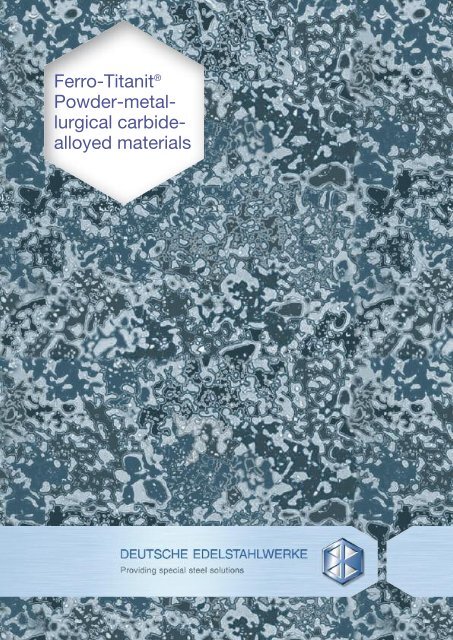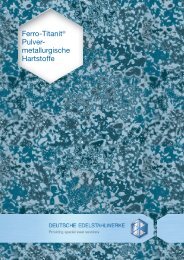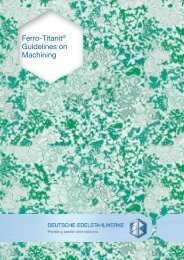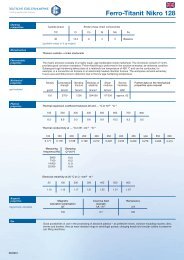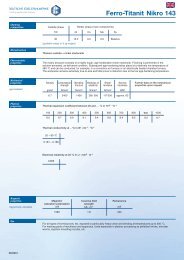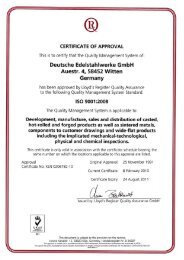Ferro-Titanit - Deutsche Edelstahlwerke GmbH
Ferro-Titanit - Deutsche Edelstahlwerke GmbH
Ferro-Titanit - Deutsche Edelstahlwerke GmbH
Create successful ePaper yourself
Turn your PDF publications into a flip-book with our unique Google optimized e-Paper software.
<strong>Ferro</strong>-<strong>Titanit</strong> ®<br />
Powder-metallurgical<br />
carbidealloyed<br />
materials
Contents<br />
04 <strong>Ferro</strong>-<strong>Titanit</strong> ® – properties and advantages<br />
Data sheets<br />
06 <strong>Ferro</strong>-<strong>Titanit</strong> ® C-Spezial<br />
08 <strong>Ferro</strong>-<strong>Titanit</strong> ® WFN<br />
10 <strong>Ferro</strong>-<strong>Titanit</strong> ® S<br />
12 <strong>Ferro</strong>-<strong>Titanit</strong> ® Nikro 128<br />
14 <strong>Ferro</strong>-<strong>Titanit</strong> ® Nikro 143<br />
16 <strong>Ferro</strong>-<strong>Titanit</strong> ® Cromoni<br />
17 <strong>Ferro</strong>-<strong>Titanit</strong> ® U<br />
18 Examples of use<br />
20 Guidelines on machining<br />
02
Highly wearresistant,<br />
light,<br />
machinable,<br />
hardenable<br />
<strong>Ferro</strong>-<strong>Titanit</strong> ® is the trademark used by <strong>Deutsche</strong><br />
<strong>Edelstahlwerke</strong> <strong>GmbH</strong> (WK) for ultrahighalloyed,<br />
machinable and hardenable alloys made by powder<br />
metallurgy techniques. The materials combine the<br />
properties of steel and tungsten-carbide alloys and<br />
are highly wear-resistant.<br />
<strong>Ferro</strong>-<strong>Titanit</strong> ® has a titanium carbide content of around 45%<br />
by volume, embedded in an alloyed steel binder phase.<br />
In as-delivered condition, this material can be machined by conventional<br />
methods. In heat-treated, hardened condition (up to 69 HRC),<br />
<strong>Ferro</strong>-<strong>Titanit</strong> ® can be used to solve many wear problems economically.<br />
04
<strong>Ferro</strong>-<strong>Titanit</strong> ® is hardenable up to 69 HRC.<br />
A simple heat treatment brings about a<br />
considerably higher hardness than for steel.<br />
The tools have exceptionally long service lives.<br />
Appreciable savings are achieved as a result of<br />
lower tool costs. Tool changeover costs are<br />
reduced through longer machine operating<br />
times.<br />
<strong>Ferro</strong>-<strong>Titanit</strong> ® can be hardened with extremely<br />
little distortion, since titanium carbide has a low<br />
thermal expansion and no transformation.<br />
The microstructure is free from segregations<br />
and fibering due to the powder metallurgy<br />
process. Vacuum hardening is advisable,<br />
as otherwise the negative influence zones on<br />
the tools require a greater machining allowance.<br />
In the case of C-Spezial, hardening and<br />
tempering cause an increase in the original<br />
dimensions.<br />
WFN and S grades are shrink in dimensions<br />
due to retained austenite. Deep cooling in liquid<br />
nitrogen, on the other hand, increases the<br />
dimensions of these grades. The dimensional<br />
change is in each case less than 0.1%.<br />
<strong>Ferro</strong>-<strong>Titanit</strong> ® offers good possible combina -<br />
tions with steel (e.y. high temperature brazing).<br />
When used in combination, <strong>Ferro</strong>-<strong>Titanit</strong> ® is<br />
applied only in areas exposed to wear.<br />
The steel, as the substrate, permits material<br />
savings, offers higher toughness, and can be<br />
machined more cost-effectively.<br />
<strong>Ferro</strong>-<strong>Titanit</strong> ® allows reutilisation of used<br />
tools.<br />
Used tools and wearing parts can be annealed<br />
as often as required and processed into new<br />
parts (no change in the microstructure).<br />
Minimum remachining in the soft-annealed<br />
condition permits swift replacement of failed<br />
tool or wearing components (example:<br />
remachining of a drawing tool to produce a<br />
larger profile).<br />
<strong>Ferro</strong>-<strong>Titanit</strong> ® is machinable according to<br />
given guidelines (siehe Seiten 20, 21).<br />
It can be machined in the annealed asdelivered<br />
condition by conventional methods,<br />
such as turning, planing, milling, drilling, and<br />
other means.<br />
Company-own tool shops can be employed,<br />
producing long-life tools at a relatively low total<br />
cost.<br />
<strong>Ferro</strong>-<strong>Titanit</strong> ® exhibits minimum pick-up.<br />
The titanium carbides in <strong>Ferro</strong>-<strong>Titanit</strong> ® (45% by<br />
vol.) do not alloy with other materials.<br />
The hardly detectable pick-up with wellpolished<br />
tools and dies – especially deepdrawing<br />
tools – and the high wear resistance<br />
lead to high outputs between remachinings,<br />
combined with a best-quality surface finish.<br />
<strong>Ferro</strong>-<strong>Titanit</strong> ® has a low specific weight.<br />
<strong>Ferro</strong>-<strong>Titanit</strong> ® is 50% lighter than tungsten<br />
carbide and still 15% lighter than steel.<br />
05
<strong>Ferro</strong>-<strong>Titanit</strong> ®<br />
C-Spezial<br />
Chemical Carbide phase Binder phase (main components)<br />
composition TiC C Cr Mo Fe<br />
33 0.65 3.0 3.0 Balance<br />
(guideline values in % by weight)<br />
Microstructure<br />
Characteristic<br />
properties<br />
Titanium carbide + martensite<br />
The binder phase consists of a cold work steel containing 3% chromium and 3% molybdenum.<br />
The relatively low alloy content brings about a low tempering resistance. The hardness decreases above<br />
approximately 200 °C. In comparison with the other grades, C-Spezial has the best machining properties.<br />
Mechanical Density Com- Bending Modulus of Shear Service Further data on<br />
properties pression fracture elasticity modulus hardness the mechanical<br />
hardened + tempered strength properties upon<br />
g/cm 3 MPa MPa MPa MPa HRC request<br />
6.5 3800 1500 292000 117000 approx. 69<br />
Physical Thermal expansion coefficient between 20 and … °C in 10 -6 · °C -1<br />
properties 100 200 300<br />
9.2 9.1 9.8<br />
Thermal conductivity at 20 °C in W · cm -1 · °C -1<br />
0.205<br />
Measuring frequency (Hz) Damping Q -1 (10 -5 )<br />
2600 14<br />
7000 22<br />
22000 16<br />
Electrical resistivity at 20 °C in · mm 2 · m -1<br />
0.75<br />
Magnetic Magnetic saturation polarisation Coercive field strength Remanence<br />
properties mT kA · m -1 mT<br />
920 5.0 315<br />
Use<br />
All cold work applications in cutting and forming engineering, e.g. for cutting and blanking tools, bending<br />
jaws, extrusion punches, deep-drawing dies, form and hobbing punches, clamping jaws, blanking sleeves,<br />
tools for the processing of steel, non-ferrous metals, aluminium, etc., as well as machine elements such as<br />
pulleys, rollers and guides exposed to heavy wear.<br />
06
<strong>Ferro</strong>-<strong>Titanit</strong> ®<br />
C-Spezial<br />
Annealing Annealing Cooling Hardness after Transformation range °C<br />
temperature °C<br />
annealing HRC<br />
Soft 750 (10 h) Furnace approx. 49 800 – 852<br />
Stress-relieving<br />
If extensive machining is required, it is advisable, after rough-machining, i.e. before finish-machining, to<br />
stress-relief anneal at around 600 – 650 °C, followed by cooling in the furnace.<br />
Hardening Hardening Hardening Quenching Transformation range °C<br />
temperature °C medium<br />
980 – 1100 Vacuum min 1 bar N 2 800 – 852<br />
Heating to hardening temperature is advisably performed over several preheating stages (e.g. 400 °C,<br />
600 °C, 800 °C) in order to ensure uniform soaking of the parts that are to be hardened and to avoid any<br />
cracking induced by thermal stress. The selected soaking time at hardening temperature must be longer<br />
than for steel tools (roughly twice to three times). Because of the rigid titanium carbide skeleton, deleterious<br />
grain growth as found in tool steel and high-speed steel cannot occur during the heat treatment. It is hence<br />
possible to accept slightly higher hardening temperatures and longer soaking times rather than insufficient<br />
hardening.<br />
Tempering Tempering temperature °C Service hardness HRC<br />
150 approx. 69<br />
In order to avoid cracking induced by hardening stresses, parts that have been hardened must be tempered<br />
immediately after quenching or cooling to around 50 °C and held at tempering temperature for at least<br />
2 hours, followed by cooling in air.<br />
Dimensional changes<br />
Due to the hardening and tempering of C-Spezial, the original dimensions increase. The change in<br />
dimensions is less than 0.1%.<br />
Tempering curve<br />
Hardness in HRC<br />
72<br />
70<br />
68<br />
66<br />
64<br />
62<br />
Note:<br />
No tempering temperature other than<br />
the one indicated should be selected,<br />
as the strong, negative influence on the<br />
resistance to wear and pick-up does not<br />
justify the minor benefit of toughness<br />
improvement.<br />
60<br />
58<br />
56<br />
100 200 300 400 500 600 700<br />
Tempering temperature in °C<br />
07
<strong>Ferro</strong>-<strong>Titanit</strong> ®<br />
WFN<br />
Chemical Carbide phase Binder phase (main components)<br />
composition TiC C Cr Mo Fe<br />
33.0 0.75 13.5 3.0 Balance<br />
(guideline values in % by weight)<br />
Microstructure<br />
Characteristic<br />
properties<br />
Titanium carbide + martensite<br />
Because of its 13.5% chromium and 3% molybdenum content, WFN has a high tempering resistance up to<br />
around 450 °C, as well as high-temperature hardness and good corrosion resistance. The thermal expansion<br />
coefficient is adjusted to that of steel through the 1% aluminium alloy addition. Lower stresses thereby<br />
occur when non-permanent and permanent joints are heated, reducing the risk of cracking.<br />
Mechanical Density Comp- Bending Modulus of Shear Service Further data on<br />
properties pression fracture elasticity modulus hardness the mechanical<br />
hardened + tempered strength properties upon<br />
g/cm 3 MPa MPa MPa MPa HRC request<br />
6.5 3600 1200 294000 122000 approx. 69<br />
Physical Thermal expansion coefficient between 20 and … °C in 10 -6 · °C -1<br />
properties 100 200 300 400 500 600<br />
10.6 11.6 12.2 12.4 12.7 12.9<br />
Thermal conductivity at 20 °C in W · cm -1 · °C -1<br />
0.182<br />
Measuring frequency (Hz) Damping Q -1 (10 -5 )<br />
2600 27<br />
7100 33<br />
22000 27<br />
Electrical resistivity at 20 °C in · mm 2 · m -1<br />
0.91<br />
Magnetic Magnetic saturation polarisation Coercive field strength Remanence<br />
properties mT kA · m -1 mT<br />
590 9.2 160<br />
Use<br />
All cold work applications in cutting and forming engineering. In particular for tools and wearing parts<br />
required to have a high tempering resistance up to 450 °C as well as elevated corrosion resistance,<br />
e.g. guide rollers for wire rod and bar steel rolling, injection moulds for plastics processing, jets for steam-jet<br />
equipment, valve components, tube drawing dies, extrusion dies for the manufacture of aerosol cans,<br />
cold rollers.<br />
08
<strong>Ferro</strong>-<strong>Titanit</strong> ®<br />
WFN<br />
Annealing Annealing Cooling Hardness after Transformation range °C<br />
temperature °C<br />
annealing HRC<br />
Soft 750 (10 h) Furnace approx. 51 890 – 970<br />
Stress-relieving<br />
If extensive machining is required, it is advisable, after rough-machining, i.e. before finish-machining,<br />
to stress-relief anneal at around 600 – 650 °C, followed by cooling in the furnace.<br />
Hardening Hardening Hardening Quenching Transformation range °C<br />
temperature °C medium<br />
1080 Vacuum min 1 bar N 2 890 – 970<br />
Heating to hardening temperature is advisably performed over several preheating stages (e.g. 400 °C,<br />
600 °C, 800 °C) in order to ensure uniform soaking of the parts that are to be hardened and to avoid any<br />
cracking induced by thermal stress. The selected soaking time at hardening temperature must be longer<br />
than for steel tools (roughly twice to three times). Because of the rigid titanium carbide skeleton, deleterious<br />
grain growth as found in tool steel and high-speed steel cannot occur during the heat treatment. It is hence<br />
possible to accept slightly higher hardening temperatures and longer soaking times rather than insufficient<br />
hardening.<br />
Tempering Tempering temperature °C Service hardness HRC<br />
460 approx. 69<br />
In order to avoid cracking induced by hardening stresses, parts that have been hardened must be tempered<br />
immediately after quenching or cooling to around 50 °C and held at tempering temperature for at least<br />
2 hours, followed by cooling in air.<br />
Dimensional changes<br />
The WFN grade exhibits a reduction in dimensions due to retained austenite. The dimensions are increased<br />
in this grade, however, by deep-cooling in liquid nitrogen or also repeated tempering. The change in<br />
dimensions is less than 0.1% in each case.<br />
Tempering curve<br />
Hardness in HRC<br />
70<br />
68<br />
66<br />
64<br />
62<br />
Note:<br />
No tempering temperature other<br />
than the one indicated should be<br />
selected, as the strong, negative<br />
influence on the resistance to wear<br />
and pick-up does not justify the<br />
minor benefit of toughness improvement.<br />
60<br />
350 370 390 410 430 450 470 490 510 530 550<br />
Tempering temperature in °C<br />
09
<strong>Ferro</strong>-<strong>Titanit</strong> ®<br />
S<br />
Chemical Carbide phase Binder phase (main components)<br />
composition TiC C Cr Mo Fe<br />
32.0 0.5 19.5 2.0 Balance<br />
(guideline values in % by weight)<br />
Microstructure<br />
Characteristic<br />
properties<br />
Titanium carbide + martensite<br />
Because of its high chromium and reduced carbon content, this grade is recommended in cases requiring<br />
elevated corrosion resistance.<br />
Mechanical Density Com- Bending Modulus of Shear Service Further data on<br />
properties pression fracture elasticity modulus hardness the mechanical<br />
hardened + tempered strength properties upon<br />
g/cm 3 MPa MPa MPa MPa HRC request<br />
6.5 3700 1050 290000 116000 approx. 67<br />
Physical Thermal expansion coefficient between 20 and 400 °C in 10 -6 · °C -1<br />
properties 9.7<br />
Thermal conductivity at 20 °C in W · cm -1 · °C -1<br />
0.188<br />
Measuring frequency (Hz) DampingQ -1 (10 -5 )<br />
2600 19<br />
7100 25<br />
22300 18<br />
Electrical resistivity at 20 °C in · mm 2 · m -1<br />
0.77<br />
Magnetic Magnetic saturation polarisation Coercive field strength Remanence<br />
properties mT kA · m -1 mT<br />
620 9.8 108<br />
Use<br />
For parts requiring a high resistance to corrosion as well as to wear, e.g. pumps, measuring tools, thrust<br />
disks, bearings, etc.<br />
10
<strong>Ferro</strong>-<strong>Titanit</strong> ®<br />
S<br />
Annealing Annealing °C Cooling Hardness after Transformation range °C<br />
temperature °C<br />
annealing HRC<br />
Soft 750 (10 h) Furnace approx. 51 800 – 850<br />
Stress-relieving<br />
If extensive machining is required, it is advisable, after rough-machining, i.e. before finish-machining,<br />
to stress-relief anneal at around 600 – 650 °C, followed by cooling in the furnace.<br />
Hardening Hardening °C Hardening Quenching Transformation range °C<br />
temperature °C medium<br />
1080 Vacuum min 1 bar N 2 800 – 850<br />
Heating to hardening temperature is advisably performed over several preheating stages (e.g. 400 °C,<br />
600 °C, 800 °C) in order to ensure uniform soaking of the parts that are to be hardened and to avoid any<br />
cracking induced by thermal stress. The selected soaking time at hardening temperature must be longer<br />
than for steel tools (roughly twice to three times). Because of the rigid titanium carbide skeleton, deleterious<br />
grain growth as found in tool steel and high-speed steel cannot occur during the heat treatment. It is hence<br />
possible to accept slightly higher hardening temperatures and longer soaking times rather than insufficient<br />
hardening.<br />
Tempering Tempering temperature °C Service hardness HRC<br />
180 approx. 67<br />
In order to avoid cracking induced by hardening stresses, parts that have been hardened must be tempered<br />
immediately after quenching or cooling to around 50 °C and held at tempering temperature for at least<br />
2 hours, followed by cooling in air.<br />
Dimensional changes<br />
The S grade exhibits a reduction in dimensions due to retained austenite. The dimensions are increased<br />
in this grade, however, by deep-cooling in liquid nitrogen or also repeated tempering. The change in<br />
dimensions is less than 0.1% in each case.<br />
Tempering curve<br />
72<br />
70<br />
Hardness in HRC<br />
68<br />
66<br />
64<br />
62<br />
60<br />
58<br />
56<br />
54<br />
100 200 300 400 500<br />
Tempering temperature in °C<br />
11
<strong>Ferro</strong>-<strong>Titanit</strong> ® Nikro 128<br />
Chemical Carbide phase Binder phase (main components)<br />
composition TiC Cr Co Ni Mo Fe<br />
30 13.5 9 4 5 Balance<br />
(guideline values in % by weight)<br />
Microstructure<br />
Characteristic<br />
properties<br />
Titanium carbide + nickel martensite<br />
The matrix structure consists of a highly tough, age-hardenable nickel martensite. The chromium content of<br />
13.5 % provides good corrosion resistance. Finish-machining is performed in the solution-annealed, asdelivered<br />
condition. Subsequent age-hardening takes place at a relatively low temperature of 480 °C and<br />
can be conducted, for example, in a convection air furnace or an electrically heated chamber furnace.<br />
The workpiece remains extremely true-to-size and little prone to distortion due to the low age-hardening<br />
temperature.<br />
Mechanical Density Com- Bending Modulus of Shear Service Further data on<br />
properties pression racture elasticity modulus hardness the mechanical<br />
age-hardened strength properties upon<br />
g/cm 3 MPa MPa MPa MPa HRC request<br />
6.6 2750 1200 294000 117000 approx. 62<br />
Physical Thermal expansion coefficient between 20 and … °C in 10 -6 · °C -1<br />
properties 100 200 300 400 500 600 700 800<br />
8.3 8.9 9.3 9.6 9.9 10.2 9.2 9.5<br />
Thermal conductivity at … °C in W · cm -1 · °C -1<br />
100 150 200 250 300 350 400 450 500 550 600<br />
0.171 0.178 0.188 0.199 0.212 0.226 0.242 0.259 0.276 0.295 0.315<br />
Measuring frequency (Hz) Damping Q -1 (10 -5 )<br />
2600 10.0<br />
7100 15.2<br />
14000 11.9<br />
22000 10.9<br />
Electrical resistivity at … °C in · mm 2 · m -1<br />
20 100 200 300 400 500 600<br />
1.10 1.12 1.17 1.21 1.25 1.31 1.67<br />
Magnetic Magnetic saturation polarisation Coercive field strength Remanence<br />
properties mT kA · m -1 mT<br />
magnetically clampable 740 3.7 190<br />
Use<br />
Good possibilities of use in the processing of abrasive plastics – as pelletizer knives, injection moulding<br />
nozzles, dies, worms and bushes. Also as wear-resistant rings in centrifugal pumps, charging heads and<br />
circular cutters in preservecan filling machines.<br />
12
<strong>Ferro</strong>-<strong>Titanit</strong> ® Nikro 128<br />
Solution annealing Annealing temperature °C Cooling Hardness after annealing HRC<br />
850 ( 2 – 4 h vacuum) 1 – 4.5 bar N 2 approx. 53<br />
The material is supplied in solution-annealed condition by the producer. Due to this fact, only ageing at<br />
480 °C is still required after finish-machining.<br />
Age-hardening Age-hardening temperature °C Hardness after age-hardening HRC<br />
480 ( 6 – 8 h) approx. 62<br />
Age-hardening curve<br />
Hardness in HRC<br />
64<br />
60<br />
56<br />
52<br />
Note:<br />
Carburising atmospheres are to<br />
be avoided during heat treatment.<br />
Linear shrinkage during agehardening<br />
is generally 0.02 mm/m.<br />
48<br />
400 450 500 550 600 650<br />
Age-hardening temperature in °C<br />
13
<strong>Ferro</strong>-<strong>Titanit</strong> ® Nikro 143<br />
Chemical Carbide phase Binder phase (main components)<br />
composition TiC Ni Co Mo Fe<br />
30 15.0 9.0 6.0 Balance<br />
(guideline values in % by weight)<br />
Microstructure<br />
Characteristic<br />
properties<br />
Titanium carbide + nickel martensite<br />
The matrix structure consists of a highly tough, age-hardenable nickel martensite.<br />
Finishing is performed in the solution-annealed, as-delivered condition. Subsequent age-hardening takes<br />
place at a relatively low temperature of 480 °C and can be conducted, for example, in a convection air<br />
furnace or an electrically heated chamber furnace. The workpiece remains extremely true-to-size and little<br />
prone to distortion due to the low age-hardening temperature.<br />
Mechanical Density Com- Bending Modulus of Shear Service Further data on<br />
properties pression fracture elasticity modulus hardness the mechanical<br />
age-hardened strength properties upon<br />
g/cm 3 MPa MPa MPa MPa HRC request<br />
6.7 2400 1450 280000 117000 approx. 63<br />
Physical Thermal expansion coefficient between 20 and … °C in 10 -6 · °C -1<br />
properties 100 200 300 400 500 600 700 800 900 1000<br />
8.0 8.7 8.9 9.1 9.4 9.8 9.4 8.5 9.2 9.7<br />
Thermal conductivity at W · cm -1 · °C -1<br />
20 – 80 °C<br />
0.181 – 0.189<br />
Electrical resistivity at 20 °C in · mm 2 · m -1<br />
0.806<br />
Magnetic Magnetic saturation polarisation Coercive field strength Remanence<br />
properties mT kA · m -1 mT<br />
magnetically clampable 1580 1.8 230<br />
Use<br />
For all types of forming tools, etc. exposed to particularly heavy wear and bending at temperatures up to<br />
500 °C. For wearing parts of machinery and apparatus. Used especially in plastics processing as pelletizer<br />
knives, extruder worms, injection moulding nozzles, etc.<br />
14
<strong>Ferro</strong>-<strong>Titanit</strong> ® Nikro 143<br />
Solution annealing Annealing temperature °C Cooling Hardness after annealing HRC<br />
850 ( 2 – 4 h vacuum) 1 – 4.5 bar N 2 approx. 53<br />
Age-hardening Age-hardening temperature °C Hardness after age-hardening HRC<br />
480 ( 6 – 8 h) approx. 63<br />
Age-hardening curve<br />
Hardness in HRC<br />
64<br />
62<br />
60<br />
58<br />
56<br />
54<br />
52<br />
Note:<br />
50<br />
350 400 450 500 550 600 650 700<br />
Age-hardening temperature in °C<br />
Carburising atmospheres are to<br />
be avoided during heat treatment.<br />
Linear shrinkage during agehardening<br />
is generally 0.02 mm/m.<br />
15
<strong>Ferro</strong>-<strong>Titanit</strong> ®<br />
Cromoni<br />
Chemical Carbide phase Binder phase (main components)<br />
composition TiC Cr Mo Ni<br />
22.0 20.0 15.5 Balance<br />
(guideline values % by weight)<br />
Microstructure<br />
Characteristic<br />
properties<br />
Titanium carbide + austenite<br />
Supplied in solution-annealed condition. <strong>Ferro</strong>-<strong>Titanit</strong> ® Cromoni is non-magnetisable, even after ageing at<br />
temperatures up to 900 °C. Besides having a high wear resistance, this alloy is extremely resistant to<br />
corrosion and scaling, as well as highly tempering-resistant. This corrosion resistance is at its best with finely<br />
ground or polished surfaces.<br />
Mechanical Density Com- Bending Modulus of Service Further data on<br />
properties pression fracture elasticity hardness the mechanical<br />
age-hardened strength properties upon<br />
g/cm 3 MPa MPa MPa HRC request<br />
7.4 1500 1300 277000 approx. 54<br />
Physical Thermal expansion coefficient between 20 and … °C in 10 -6 · °C -1<br />
properties 100 200 300 400 500 600<br />
9.0 10.0 10.5 10.8 11.1 11.5<br />
Thermal conductivity at 20 °C in W · cm -1 · °C -1<br />
0.124<br />
Measuring frequency (Hz) Damping Q -1 (10 -5 )<br />
2400 6<br />
6600 7<br />
21000 11<br />
Electrical resistivity at 20 °C in · mm 2 · m -1<br />
1.53<br />
Magnetic Permeability µ<br />
properties < 1.01<br />
Use<br />
This austenitic grade is used for applications requiring complete non-magnetisability, a high wear resistance<br />
and maximum corrosion resistance.<br />
Solution annealing Annealing temperature °C Cooling Hardness after annealing HRC<br />
1200 (2 h vacuum) 4 bar N 2 approx. 52<br />
Age-hardening Age-hardening temperature °C Hardness after age-hardening HRC<br />
800 (6 h vacuum) approx. 54<br />
Note<br />
Machining according to guidelines, at lowest cutting speeds.<br />
16
<strong>Ferro</strong>-<strong>Titanit</strong> ®<br />
U<br />
Chemical Carbide phase Binder phase (main components)<br />
composition TiC Cr Ni Mo Fe<br />
34 18 12 2 Balance<br />
(guideline values in % by weight)<br />
Microstructure<br />
Titanium carbide + austenite<br />
Characteristic The binder phase of <strong>Ferro</strong>-<strong>Titanit</strong> ® U is roughly equivalent to the austenitic CrNiMo steel X 10<br />
properties CrNiMoNb 18 10 (Mat. No. 1.4580). The material is non-magnetisable and, because of its high Cr and Mo<br />
contents, possesses excellent resistance to pitting corrosion in media containing chlorine ions. Its high titanium<br />
carbide content of 34 % by weight, or 45 % by volume, provides it with outstanding wear resistance.<br />
The Cr and Ni contents simultaneously give the material good scaling resistance and high-temperature<br />
strength.<br />
The material requires no later postheat treatment.<br />
Mechanical Density Com- Bending Service Further data on<br />
properties pression fracture hardness the mechanical<br />
age-hardened strength properties upon<br />
g/cm 3 MPa MPa HRC request<br />
6.6 2200 950 approx. 51<br />
Physical Thermal expansion RT-800 °C<br />
properties 12.5<br />
Thermal conductivity at 20 °C in W · cm -1 · °C -1<br />
0.180<br />
Electrical resistivity at 20 °C in · mm 2 · m -1<br />
0.96<br />
Magnetic Permeability µ<br />
properties < 1.01<br />
Use<br />
<strong>Ferro</strong>-<strong>Titanit</strong> ® U is used where non-magnetisable material with a high wear resistance is required.<br />
Its excellent corrosion resistance, in particular in media containing chlorine ions, gives it a broad range of<br />
applications in the chemical industry.<br />
17
Machining of <strong>Ferro</strong>-<strong>Titanit</strong> ®<br />
As a rule, the machinable and hardenable<br />
<strong>Ferro</strong>-<strong>Titanit</strong> ® alloys are supplied as semifinished<br />
material in soft-annealed condition.<br />
Despite a titanium carbide content of around<br />
45% by vol. and a hardness of 48 – 53 HRC<br />
after annealing, it is possible to machine these<br />
materials by conventional methods, such as<br />
turning, planing, milling, sawing and drilling,<br />
according to the guidelines given below.<br />
Any tool shop therefore has the possibility to<br />
machine tools and other wear-exposed parts<br />
on equipment normally used for machining<br />
steels.<br />
<strong>Ferro</strong>-<strong>Titanit</strong> ® can be hardened with very little<br />
distortion. There is, consequently, extremely little<br />
change in the dimensions. Where C-Spezial<br />
is concerned, hardening and tempering brings<br />
about an increase in the original dimensions.<br />
18
With the WFN and S grades, retained austenite<br />
leads to a reduction in the dimensions.<br />
Deep-cooling in liquid nitrogen makes it possible<br />
to increase the dimensons in these grades<br />
after hardening.<br />
The dimensional changes are less than 0.1% in<br />
each case.<br />
Machining in the annealed, as-delivered condition<br />
can consequently approximate the nominal<br />
size very closely, such that re-machining in<br />
hardened condition need amount to only a few<br />
hundredths of a millimetre. A precondition in<br />
this respect is that the hardening treatment to<br />
achieve the optimum service properties is<br />
performed preferably in a vacuum furnace.<br />
The machining of <strong>Ferro</strong>-<strong>Titanit</strong> ® can only be<br />
done with greatly reduced cutting speeds,<br />
compared with steel.<br />
All machining operations mentioned on pages<br />
20-23 have to be applied without lubricants or<br />
coolants.<br />
19
Turning<br />
<strong>Ferro</strong>- tool quality feed rate cutting edge angle cutting<br />
<strong>Titanit</strong> ® alernatively rake inclination clearance speed<br />
grades angle angle angle m/min<br />
C-Spezial 10<br />
WFN tungsten carbide 8<br />
S coated, 8<br />
Nikro 143 K 10 / K 30, 0.02 – 0.1 mm/rev. 6 ° / 15 ° 0 ° / – 6 ° 6 ° / – 11 ° 5<br />
Nikro 128 high-speed 5<br />
U steel 5<br />
Cromoni 0.02 – 0.04 mm/rev. 2.5<br />
all<br />
ceramics,<br />
grades fiber-reinforced<br />
~ 0.1 – 0.5 mm/rev. – 6 ° – 6 ° + 6 ° > 25<br />
Milling<br />
<strong>Ferro</strong>- tool quality feed rate cutting<br />
<strong>Titanit</strong> ® alernatively speed<br />
grades<br />
m/min<br />
C-Spezial<br />
WFN<br />
tungsten carbide<br />
S<br />
coated,<br />
Nikro 143<br />
K 10 / K 30,<br />
0.01 – 0.07 mm/tooth 6 – 12<br />
Nikro 128<br />
high-speed steel<br />
U<br />
Cromoni ~ 0.01 mm/tooth 2 – 5<br />
20
Drilling<br />
<strong>Ferro</strong>- tool quality feed rate cutting<br />
<strong>Titanit</strong> ® alernatively speed<br />
grades<br />
m/min<br />
tungsten carbide<br />
all<br />
coated,<br />
grades K 10 / K 30,<br />
0.05 mm/U rake angel 90 – 120 ° 2 – 4<br />
high-speed steel<br />
Thread cutting<br />
<strong>Ferro</strong>- tool quality feed rate rake cutting<br />
<strong>Titanit</strong> ® alernatively angle speed<br />
grades<br />
m/min<br />
all<br />
grades<br />
tungsten carbide<br />
high-speed steel<br />
cutting edge champfer<br />
0 1.5 – 2 mm wide, 2 – 4<br />
extensive undercut<br />
Sawing*<br />
<strong>Ferro</strong>- tool quality feed rate constant “a” for calculation cutting<br />
<strong>Titanit</strong> ® alernatively of feed rate speed<br />
grades<br />
m/min<br />
C-Spezial<br />
WFN<br />
800 mm 2 /min<br />
S<br />
constant a<br />
Nikro 143 bimetall M 42 length of saw notch ~10<br />
Nikro 128<br />
600 mm 2 /min<br />
U<br />
Cromoni 200 mm 2 /min < 5<br />
* band saw (preferably) hack saw (in exceptional cases)<br />
recommended partition length of conventional combi<br />
of saw bands saw notch toothing toothing<br />
up to 30 mm 10 teeth/inch 8/12 teeth/inch<br />
30 – 70 mm 8 teeth/inch 5/8 teeth/inch<br />
7 – 120 mm 4 teeth/inch 4/6 teeth/inch<br />
> 120 mm 3 teeth/inch 2/3 teeth/inch<br />
21
Grinding<br />
The high carbide content and the titanium carbide’s high hardness make it self-evident that special attention must<br />
be paid when grinding. In this respect, it is of decisive importance whether the carbides are present in a softannealed<br />
or in a hardened steel binder phase. Grinding in hardened condition leads to significantly higher grinding<br />
wheel wear.<br />
Corundum wheels with a ceramic bond, porous structure and fine grain have proven a suitable medium. In case of<br />
special questions, the grinding wheel manufacturer should be consulted.<br />
Diamond wheels made from plastic-bonded, nickel-coated synthetic diamonds with a concentration of 75 c –<br />
100 c in a diamond grit size of D 107 - D 151 are recommended particularly for the finish-grinding of <strong>Ferro</strong>-<strong>Titanit</strong> ®<br />
in hardened condition.<br />
Attention must be paid to the following basic rules when grinding:<br />
1. Grind with a powerful, rinsing stream of coolant directed as close as possible<br />
to the wheel/workpiece contact point.<br />
2. Select the smallest possible in-feed rate.<br />
Polishing<br />
The surface quality of the high-grade <strong>Ferro</strong>-<strong>Titanit</strong> ® carbide-alloyed materials is important for tool and machine<br />
part durability. Grinding to a best possible surface quality should generally be followed by polishing with a diamond<br />
polishing paste in order to achieve an ideal surface quality.<br />
Rough-polishing is performed with diamond fine grit D 15 (10 – 25 µm), and finish-polishing with D 3 (2 – 5 µm).<br />
If necessary, this may be followed by polishing with D 1 (1 – 2 µm).<br />
Spark-erosion machining<br />
During spark erosion, <strong>Ferro</strong>-<strong>Titanit</strong> ® carbide alloys, tool steels and tungsten carbide alloys are subjected to the<br />
same influences. The overall behaviour when <strong>Ferro</strong>-<strong>Titanit</strong> ® is eroded tends to be similar to that of tool steels.<br />
As spark erosion leads to generally strong, negative influences being exerted on tool surfaces, depending on the<br />
amperage applied, <strong>Ferro</strong>-<strong>Titanit</strong> ® should be finish-eroded with a low pulse energy.<br />
Spark-erosion roughing should be followed by a finishing and a fine-finishing operation in order to achieve the<br />
lowest possible surface roughness and freedom from cracking. Re-machining is necessary after such erosion<br />
including, where possible, stress-relieving treatment to reduce the stresses that have come about during the<br />
sintering process.<br />
22
General note (liability)<br />
All statements regarding the properties or utilisation of the materials or products mentioned are for<br />
the purposes of description only. Guarantees regarding the existence of certain properties or a certain<br />
utilisation are only ever valid if agreed upon in writing.<br />
23
DEUTSCHE EDELSTAHLWERKE GMBH<br />
Oberschlesienstr. 16<br />
47807 Krefeld, Germany<br />
sales@ferro-titanit.com<br />
www.dew-stahl.com<br />
www.ferro-titanit.com


